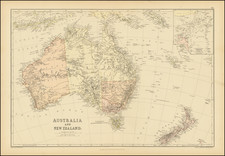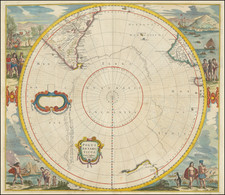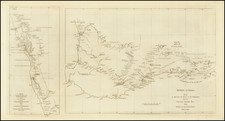Finely executed map of the exploring expedition in Northern Australia, led by Augustus Gregory between 1855 and 1858.
In the middle of the 19th Century, vast swaths of Australia remained uncharted and largely unknown to European settlers. Augustus Charles Gregory's expedition of North Australia in 1858 was an important early exploration of the north, aiming to map the unexplored territories, ascertain natural resources, and facilitate future settlement and economic opportunities. The expedition culminated in the publication of a map in connection with the presentation of the Journal at a meeting of the Royal Geographic Society.
The expedition began in August 1855 from Moreton Bay in Queensland, and by the time it concluded in 1858, Gregory and his team had covered an impressive area stretching across parts of modern-day Queensland and the Northern Territory. Some of the significant places visited during the expedition included the Victoria River, Sturt Creek, and Cooper Creek. In addition to charting rivers, Gregory also named numerous mountains and other geographical features, contributing substantially to the existing cartographical knowledge of the area.
Augustus Charles Gregory
Augustus Charles Gregory was born in England in 1819 and migrated to Western Australia with his family in 1829, initially living on land granted in the Swan River Colony, four months after its creation. By the time he took charge of the North Australia Exploring Expedition, he had already garnered significant experience in surveying and exploration, including participating in earlier expeditions in Western Australia. For much of the 1830s, Augustus took jobs to supplement the family's income. For a while he worked for a chemist, and later in partnership with his brother Joshua William as a contract surveyor. In December 1841, he joined the Government Survey Office. Between 1846 and 1858 he undertook four major expeditions. He was the first Surveyor-General of Queensland.
In 1846, Gregory embarked on his maiden exploration voyage with his two brothers, F. T. Gregory and H. C. Gregory. Departing from a station near Perth, they charted land to the north, covering 953 miles over 47 days. Two years later, in 1848, Gregory led another expedition to survey the course of the Gascoyne River and identify new pasture lands.The party managed to cover about 1500 miles in 10 weeks, successfully discovering good pastures and further entrenching Gregory's reputation as a competent and meticulous explorer.
In 1855, Gregory was appointed Assistant Surveyor of Western Australia, which led him to one of his most significant explorations. He was tasked to lead an expedition to Australia's interior, starting from Moreton Bay near Brisbane. Accompanying him were 19 men, including his brother H. C. Gregory and botanist Baron von Mueller, along with 50 horses and 200 sheep. After initial delays due to their vessel grounding on a reef, the party reached the estuary of the Victoria River. In a remarkable turn, they made first contact with the Gurindji people, marking their inaugural interaction with Europeans. Gregory also utilized the expertise of John Gilburri Fahy, an individual who had spent years living with the Bunya Mountains' aborigines, as a bush guide. Fahy helped Gregory search for the last known location of the missing explorer Ludwig Leichhardt, and in return, received a full pardon in 1857.
The team conducted several side journeys, exploring up the Victoria River and tracing Sturt’s Creek, eventually covering thousands of miles both by land and sea. Notably, Gregory also left an inscription on a large boab tree, dubbed “Gregory’s Tree,” indicating a letter's location in case his team got lost.
Gregory's journal provided a comprehensive account of the expedition, detailing observations about geography, flora, fauna, and indigenous peoples. Accompanying the journal was a meticulously detailed map that showcased the route taken by the expedition, geographical features, potential resources, and significant landmarks.










![Asia [with inset:] New Holland or Australia.](https://storage.googleapis.com/raremaps/img/small/98818.jpg)
![[South Australia] Ports in the Gulf of St. Vincent and Encounter Bay Surveyed by Comr. J. Hutchinson R.N. and assisted by F. Howard & M.S. Guy Navl. Lieutts. R.N. 1869 (Port Victor, Port Elliott, Port Willunga and Port Noarlunga)](https://storage.googleapis.com/raremaps/img/small/38744.jpg)

![[ Australia & New Zealand ] La Nuova Guinea e Nuova Galles](https://storage.googleapis.com/raremaps/img/small/86442.jpg)
